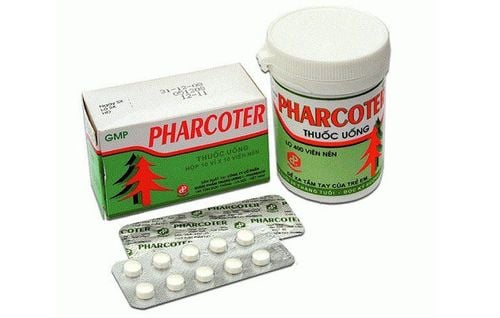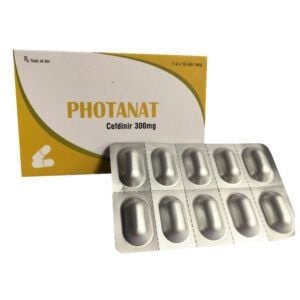This is an automatically translated article.
CTTProzil 500 is a medicine used to treat pharyngitis, tonsillitis, respiratory tract infections, skin and skin structure infections, acute otitis media. So what is CTTProzil 500? What is CTTProzil 500 used for? What is the correct way to drink? What points do you need to pay attention to, and pay attention to when using? The following article will help you better understand the uses of CTTProzil 500.1. What are the uses of CTTProzil 500?
1.1. What is CTTProzil 500? CTTProzil 500 is a medicine used to treat infections, infections and inflammation effectively. CTTProzil 500 is used to treat community-acquired pneumonia, bronchitis, cystitis, pyelonephritis. The drug has the active ingredient Cefprozil 500mg and is made in the form of
1.2 film-coated tablets. What is CTTProzil 500 used for? Effects of the main ingredient Cefprozil:
Antibiotic belonging to the 2nd generation Cephalosporin group. Mechanism: Inhibiting bacterial cell wall synthesis leading to inhibition of many Gram-negative and positive bacteria strains. Spectrum of action: Gram-positive aerobic bacteria, Gram-negative aerobic bacteria and anaerobic bacteria. Most strains of group B. fragilis and H. influenza that are resistant to Ampicillin have become resistant to the drug. CTTProzil 500 is used in the following infections:
Pharyngitis, tonsillitis. Skin and skin structure infections. Acute otitis media (AOM). Respiratory tract infections.
2. Usage of CTTProzil 500 blood pressure medicine
2.1. How to take CTTProzil 500 CTTProzil is taken orally. Take the tablet whole with plenty of water without meals.
2.2. Dosage of the drug CTTProzil 500 Children from 2 years to 12 years:
Skin and skin structure infections: 20 mg/kg every 12 hours for 10 days.
Children from 6 months to 12 years old:
Otitis media: 15 mg/kg every 12 hours for 10 days.
Acute sinusitis (for moderate and severe infections 15 mg/kg every 12 hours for 10 days.
Children ≥ 13 years old:
Pharyngitis or tonsillitis: 500 mg once daily for 10 days.
Respiratory tract infections:
Acute sinusitis : 250 mg every 12 hours for 10 days Moderate to severe infections 500 mg every 12 hours for 10 days
Secondary bacterial infections of acute bronchitis: 500 mg every 12 hour for 10 days
Uncomplicated skin and skin tissue infections 250 mg or 500 mg every 12 hours for 10 days
Adults:
Acute otitis media: 500 mg every 12 hours for 10 days. or tonsillitis 500 mg once daily for 10 days
Respiratory tract infections
Acute sinusitis: 250 mg every 12 hours for 10 days Moderate to extensive infections: 500 mg every 12 hours for 10 days.
Secondary bacterial infection of acute bronchitis: 500 mg every 12 hours for 10 days
Exacerbation of chronic bronchitis: 500 mg every 12 hours for 10 days
Skin and skin tissue infections not complications: 250 mg or 500 mg every 12 hours, for g 10 days.
Patients with hepatic impairment:
No dose adjustment is required for patients with hepatic impairment.
Patients with renal impairment:
No dose adjustment is required for patients with a creatinine clearance of 290 mL/min. In patients with creatinine clearance < 30 mL/min: The dose is approximately 50% of the usual dose.
Elderly:
No dose adjustment is required in the elderly, except for severe liver and kidney function.
Note: The above dosage is for reference only. The specific dose depends on the condition and the progression of the disease. To get the right dose, you need to consult your doctor or healthcare professional.
Handling missed dose:
Use as soon as you remember as soon as possible. Skip the missed dose if it is almost time for your next dose, take your next dose as scheduled. Overdose treatment:
Symptoms: There have been no reports of overdose in humans. For a dose of 3000 mg/kg in monkeys, diarrhea and anorexia were observed.
How to handle:
If there is any abnormality, stop using and immediately notify the doctor for timely treatment measures. In case of serious overdose, especially in patients with impaired renal function, hemodialysis should be instituted.
3. Contraindications of CTTProzil 500
The drug CTTPROZIL 500 should not be used in the following cases:
Hypersensitivity to any ingredient of the drug. Allergy to Cephalosporin antibiotics.
4. Note when using CTTProzil 500
4.1. Use with caution: Colitis and diarrhea associated with Clostridium difficile/superinfection
Possible occurrence and overgrowth of non-susceptible bacteria or fungi with prolonged use of cefprozil. Appropriate treatment should be instituted when superinfection occurs.
Antimicrobial therapy alters the normal microbiome of the colon and may allow Clostridium difficile overgrowth.
C. difficile infection (CDI) and C difficile-associated diarrhea, colitis (CDAD), also known as antibiotic-associated diarrhea, and pseudomembranous colitis or colitis have been reported to occur approximately with all antibacterial agents, including cefprozil, and can range in severity from mild diarrhea to potentially fatal colitis C. difficile produces toxins A and B which contribute to the In the development of CDAD, hypertoxin-producing C. difficile strains are associated with increased morbidity and mortality because they may be resistant to drugs and may require colectomy.
CDAD should be carefully monitored if diarrhea develops during or after drug therapy. Caution should be exercised in patients with a history of CDAD that has been reported to occur at least 2 months or longer after discontinuation of anti-infective therapy.
If CDAD is suspected or confirmed, discontinue antibiotics that are not effective against C. difficile as soon as appropriate supportive therapy (eg, rehydration and electrolytes) can be used. , protein supplementation), treatment with anti-infective drugs that are active against C. difficile (eg, metronidazol, vancomycin), and consider clinically indicated surgery.
Hypersensitivity reactions
Hypersensitivity reactions (eg, anaphylaxis, serum reactions, erythromelalgia, Stevens-Johnson syndrome) have been reported with the use of the drug. If a hypersensitivity reaction occurs, discontinue the drug immediately and institute appropriate treatment (eg, administer epinephrine, corticosteroids, maintain oxygen and adequate ventilation).
Cross-reactivity
There is a partial cross-reactivity between cephalosporins and other beta-lactam antibiotics, including penicillins and cephamycins.
Before initiating treatment, it is prudent to inquire about prior and previous hypersensitivity reactions to cephalosporins, penicillins, or other drugs. Avoid use in people where hypersensitivity (anaphylactic) reactions have occurred and caution in those who have experienced adverse events (eg, rash, fever, eosinophilia)
4.2. General Precautions Antimicrobial selection and use:
To reduce the growth of resistant bacteria and maintain the effectiveness of the drug and other minerals, use only for the treatment or prevention of infections that have been proven to be caused by drug-susceptible strains of bacteria.
History of gastrointestinal disease
Cephalosporins are used with caution in patients with a history of gastrointestinal disease, especially colitis.
Castor oil excipients contained in film-coated tablet formulations may cause abdominal pain and diarrhea when taken orally.
Can give a positive direct Coob's Test result.
Risk of drug resistance may occur if used in the absence of infection or with prolonged use. In patients with renal failure, develop non-susceptible pathogens.
4.3. Use on pregnant women and lactating mothers Pregnant women: There have been no clinical studies showing the harmful effects and safety of the drug on this subject. Ideally, consult your doctor when taking. Lactation: The drug is distributed into breast milk. Therefore, consult your doctor when using. 4.4. People who drive and operate machinery The drug may cause dizziness, drowsiness, headache, anxiety, confusion, hyperactivity. Use caution when driving and operating machinery.
5. Side effects of CTTProzil 500
Some of the reported side effects are summarized in detail by specific frequency as follows:
Common: Nausea, vaginitis, increased AST, ALT, vomiting, diarrhea, genital itching, pain belly. Uncommon: Anxiety, erythema, dizziness, somnolence, increased bilirubin, headache, urticaria, insomnia, increased Alkaline Phosphatase, hyperactivity, confusion. Rare: Increased BUN, white blood cells, serum creatinine. If any side effects appear during use, please inform your doctor or qualified pharmacist to get appropriate assistance.
6. How to store CTTProzil 500
Store in a cool, dry place, at a temperature not exceeding 30°C, in the original packaging and protected from light.
Keep out of reach of CHILDREN.
Please dial HOTLINE for more information or register for an appointment HERE. Download MyVinmec app to make appointments faster and to manage your bookings easily.













